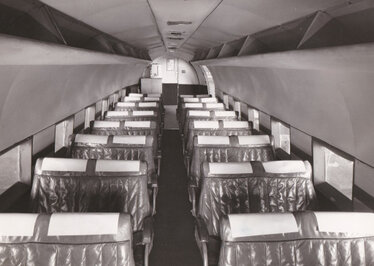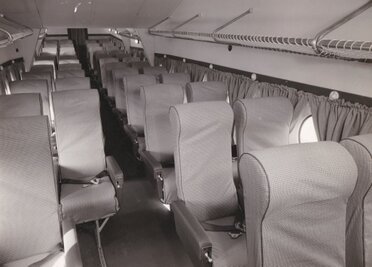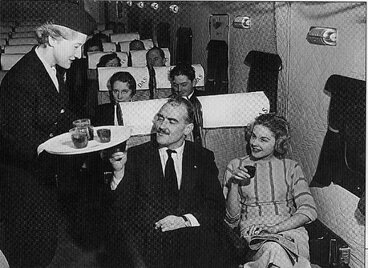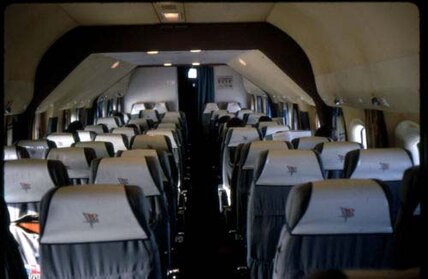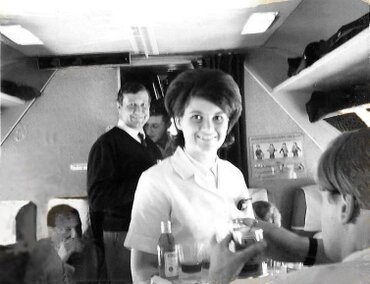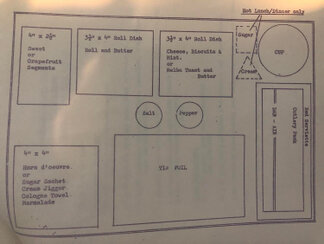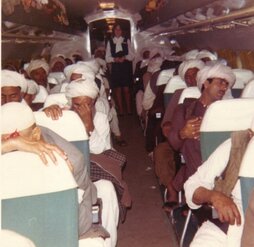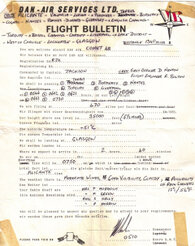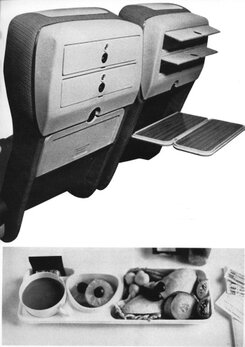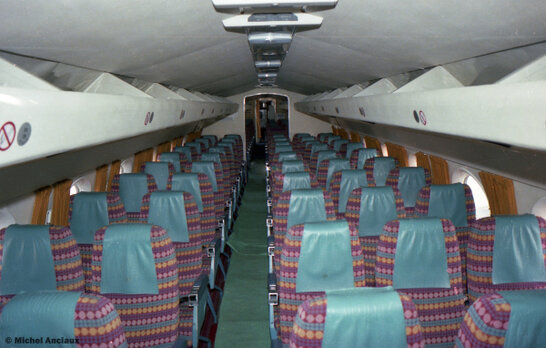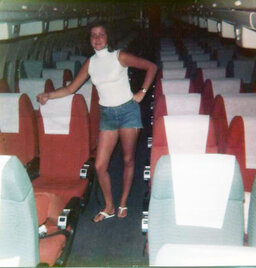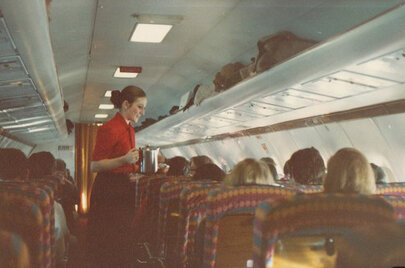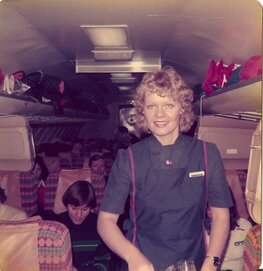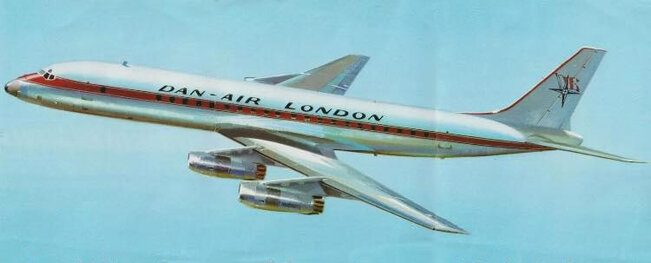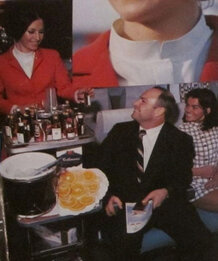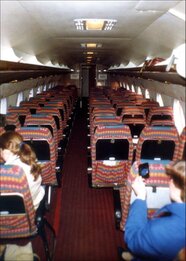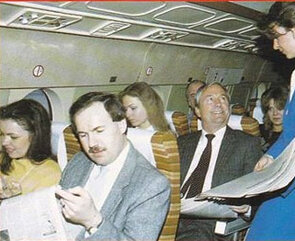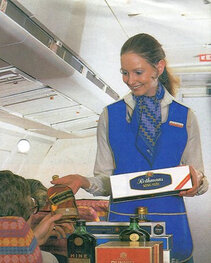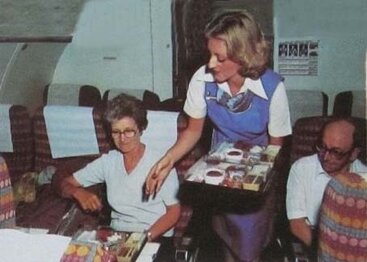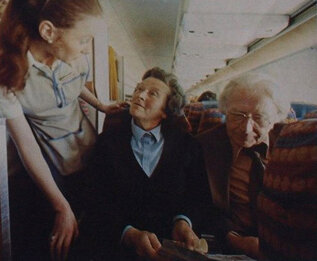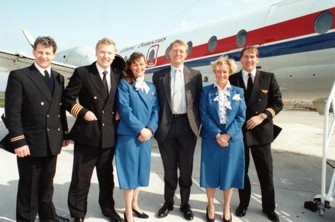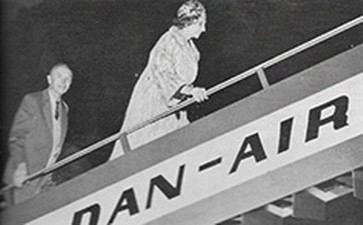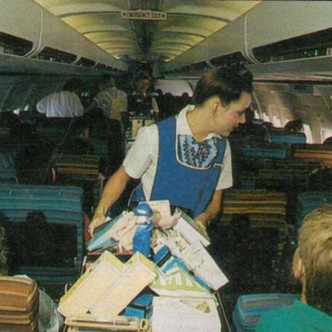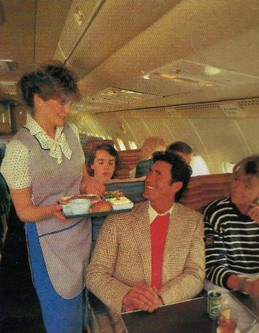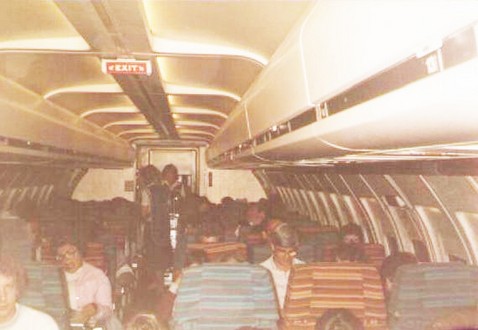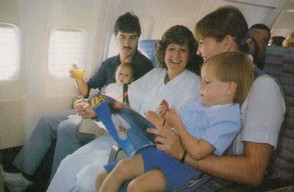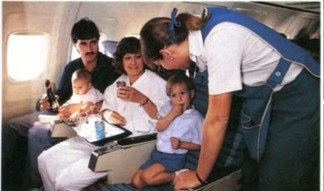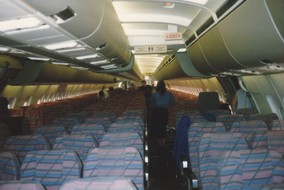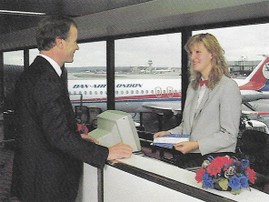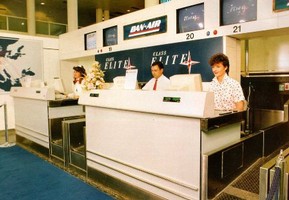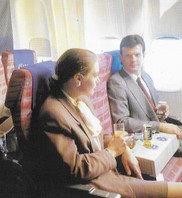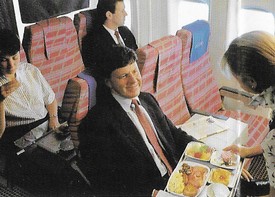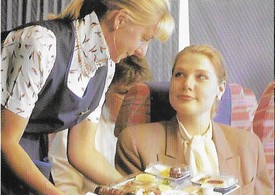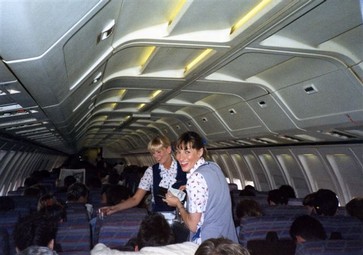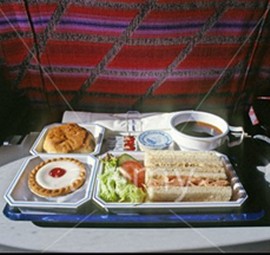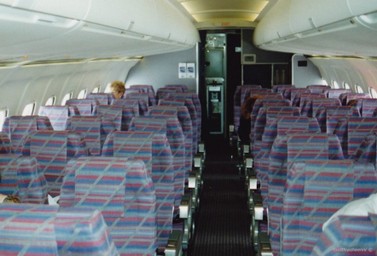

When one looks at the three pictures above it is almost impossible to imagine that the pictures were only taken 30 years or so apart. The Airpseed Ambassador heralded a new direction for Dan-Air as far as service was concerned. From then on it would not be simply a case of strap up and have a cup of tea. Service would be improved to give the airline a better image. This would meet the standards the airline set itself and the requirements of Tour Operators who would be chartering Dan-Air aircraft. As the boom in package tours took hold in the early 1960s UK airlines were a mish mash of products. The state carriers BEA and BOAC had the luxury of being able to operate scheduled services to most of the world's capital cities. Independent operators did not have the licences to compete on these routes, nor the funds to purchase aircraft to provide an alternative. The pioneering holiday-makers had to offer holidays where the scheduled carriers did not fly. This saw many Tour Operators opt for Belgium, The Netherlands, France and Germany. It wasn't until the middle of the decade that Spain really grabbed the public's attention.
To compete with other charter carriers such as British eagle and British United, Dan-Air was intent on providing the highest level of passenger care that an airline could offer.
Cabin crew would present better quality meals and drinks to passengers. How the cabin looked would be considered more than before, the crew too would need to be attractive uniform and be exceptionally well attired in their uniform. The independent airlines who were using the older piston engine aircraft did not have the galley equipment to offer hot meals. Space was at a premium, and airlines had to be able to offer a bar and duty-free goods for sale to help maximise profit. The Ambassador that Dan-Air operated did have ovens which could provide hot meals. Tour Operators did not always wish for their clients to be fed anything more than sandwiches or snacks. The launch of Britannia Airways by their parent company Thomson in the latter part of the 1960s threw the gauntlet down for both rival Tour Operators and airlines. Their aircraft seated more than 100 people and all passengers on flights of more than two hours would receive a hot meal.
In response Dan-Air stepped up their own charter fleet with the introduction of the Comet jet in 1967. This took a third off flying time and passengers would be offered hot meals. This saw a rapid growth in Dan-Air that was unparalleled at the time. In a few years the Comet was joined by BAC 1-11 twin jets, Boeing 707 intercontinental jets and Boeing 727 tri-jets. Offering Tour Operators various layouts from 89 to 189 passengers.
The middle picture above shows a Beoing 727 cabin in 1978, you can see that cabin was much bigger. A decade later, the picture on the right shows the dedicated business class cabin, 'Class Elite'. Said to be the finest business class model in Europe at the time. Dan-Air was in business for almost forty years and the change from the first to last picture above happened in less than 30 years - So let's take a closer look at how Dan-Air's on board service came about.
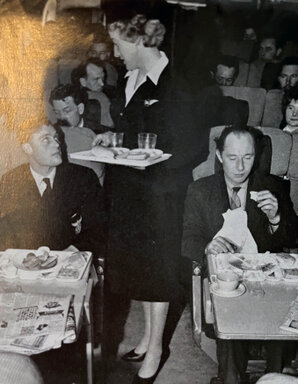
Cabin Service 1959
Dan-Air's emergence as an airline was not dynamic - the carrier's fleet consisted of a sole Douglas DC3 aircraft flying cargo, and charter flights. The cabin seated just 36 passengers. Where the flying time was less than an hour, say on a domestic flight, passengers would receive tea and biscuits, delivered with as much panache as a stewardess could in a non-pressurised cabin, flying below the smoother weather. The DC3 was not quipped with oven to heat food, and its galley was entirely made from stainless steel. On international flights the meals would be prepared in catering facilities and brought to the aircraft. What could a passenger expect? 36 meals trays could be stored in a shelved cupboard with everything the passenger needed served on the tray. Salads were a favourite, They looked attractive and kept reasonably well. Fish would be avoided due to the strong smell. Chicken was often featured, along with 'Spam' the American pressed ham. One could expect a slice of cake and bread roll. Airlines were already in the habit of using sachets for sugar, salt and pepper and individual portions of butter and jam. The Dakota could heat water, so tea and coffee would be available. Drinking habits in the 1950s were not the same as today, but charter airlines made provision for the sale of alcoholic drinks. It made financial sense. After operating for a year Dan-Air obtained two Avro York aircraft. These were much bigger and had a far greater range. They often went around the world on cargo operations or troop flights. When they were used on charter flights Dan-Air would be faced with a similar problem when providing meals. The York did have refrigeration and hot water. It also had a grill type hob, therefore hot food could be offered. Could be.....but wasn't. There was little point in grilling steaks for charter passengers flying relatively short haul routes. Nevertheless Dan-Air had now developed a training programme where their stewardesses (No males until the 80s) would do their best to make flying, and with it, the dining experience a pleasant one.
ABOVE: Interiors of the DC 3 (L) the Avro York (C) and the Bristol Freighter (R)
Dan-Air's tentative footsteps into the scheduled services arena were hampered from the start. The forerunner to the Civil Aviation Authority (CAA) - The Air Transport Licencing Board (ATLB) placed heavy restrictions on scheduled route applications from independent airlines. As far back as the 1940s charter applications could take months to be approved. European scheduled routes were generally awarded to the state owned British European Airways (BEA) and those further afield, to BOAC - British Overseas Airways Corporation. The first known charter flights took students to Italy with Horizon holidays. Its owner took a risk extending the charter offer to student nurses. Having encountered no opposition they carried on increasing flights and destinations. Scheduled services also had their fares regulated by the ATLB. When Dan-Air applied for domestic routes from its Southend base, they were generally rejected. The same thing applied when the airline moved to Blackbushe Airport, just outside of London. It took three years before a route licence was approved for Dan-Air, that being Blackbushe to Jersey. Dan-Air would have to offer at least comparable hospitality to their passengers as any other scheduled airline. The Heron joined the fleet in the mid fifties. This small aircraft and its sister ship the Dove flew domestic flights from regional airports on an expanding network known as 'Link City' The two new types had primitive catering facilities, simply providing tea and coffee to less than a dozen people. Although even that could be hazardous, both these types had the smallest of aisles and flew at altitudes where weather could induce quite a bumpy flight. Nevertheless, Dan-Air endeavoured to provide all passengers, even on short flights, with a cup of tea!
The introduction of the Bristol Freighter saw little improvement. The aircraft was later converted into a passenger carrying machine, rather than purchasing further aircraft, as the cost of obtaining large second hand aircraft was prohibitive. A chief stewardess was recruited to carry out training on new cabin crew. Recruits would find themselves taken on with very little screening. This technique was to prove successful, as many of their recruits became fiercely loyal to the company. The uniform was similar to those worn by airlines up and down the country.
ENTER THE AMBASSADOR
When Dan-Air obtained the Airspeed Ambassador in 1959. The company had taken a giant leap forward in terms of passenger comfort. The Ambassador was fairly young, having flown with BEA for only a few years. British European had began replacing their Ambassadors (known at BEA as The Elizabethan Class) with the turboprop Vickers Viscount. When the Ambassador joined Dan-Air it was configured to seat up to 55 passengers in comfort.
The Ambassador was pressurised, meaning it could fly higher and faster, and therefor smoother than any aircraft Dan-Air had hitherto operated. More to the point it had hot ovens! This is slightly misleading though. What we consider to be an in flight meal today was very different to the fare of the late fifties and early sixties.
The publicity picture of the Ambassador interior at the top the page, shows the original BEA bulkhead walls, seating and the overhead racks. BEA had used four abreast seating, which was very generous. Dan-Air would be using the aircraft for quite a different style of operation. The aircraft would now seat five abreast to enable her to carry those 55 passengers. The legroom was still quite generous. Passengers over the emergency exits would have rows of seats facing each other. This has recently been a topic of conversation on aviation forums. It is well known that this is a safer configuration, often practised by the RAF. Whether commercial airline passengers enjoyed being knee to knee with a stranger is another matter. This design was carried out later on with other Dan-Air aircraft, including the Comet, BAC 1-11 and Boeing 727. Several other airlines also employed the same practice. Most Notably British Airways with their Trident and 1-11 aircraft.
Not only did the ATLB restrict the independents on price and scheduled services, they chose where charter flights could operate. If a scheduled service flew for example, London - Barcelona, then a charter service could not fly there. This made things next to impossible at Gatwick, but opened opportunities from Manchester and other regional airports.
ABOVE: The Ambassador having had the Dan-Air makeover. Cabin service provided by Jean Broadbent on an Ambassador.
Dan-Air was now in a position to begin phasing out of converted Bristol Freighters to which the type was never really suited as a passenger aircraft. It was known to be extremely noisy and crew referred to it as the 'Bristol Frightner'. The Ambassador quickly became a favourite with passengers and crew. It could easily fly as far as Spain and, if weight was kept low, as far as Malta. More and more passengers were now choosing package holidays, but in some ways, they were flying as second class passengers. All UK independent airlines flew older, piston engined aircraft, as they were the only aircraft that were affordable. Whilst the state funded carriers were pressing ahead with turboprop aircraft and jets. The lowly independents bought their redundant fleet. Despite having hot ovens, the Ambassador did not provide hot meals to passengers due to weight, time and cost measures
In 1962 Eurvaia Airways commenced operations using old Lockheed Constellation aircraft. These piston engined giant prop-liners could carry 109 passengers. Almost double the capacity of the Ambassador. After a shaky start, Euravia was re branded as Britannia Airways in August 1964, along with a new name, came a new aircraft type. The huge Bristol Britannia, carrying 112 passengers. The airline was backed by the tour operator giant Skytours who also purchased the Bristol aircraft. The Britannia was an instant hit - it not only looked beautiful, but out performed the Ambassador in every sphere. Dan-Air would have to make the decision about whether to carry on very soon. The choice was stark - invest in new aircraft with high expenditure, continue as they were, risking being squeezed out of the market, or to close down altogether.
The decision was made to invest in newer, larger aircraft. Contacts with BOAC were made and Dan-Air found themselves in a favourable position to purchase jet aircraft in 1966. BOAC had decided, in a similar way to BEA that their Comet was outclassed by the Boeing 707. The Comet aircraft were relatively new and had lived a leisurely life flying across the world with few take-off and landings. In Dan-Air's service they would be expected to operate up to three return flights daily. Something the type was not built to do. Dan-Air placed a lot of faith in the aircraft and it didn't let them down. The negotiations were lengthy and it was not announced to the press until February 1966 that two of the eleven Comets had been purchased. In July of 1966 Judy Jacobs was appointed the Comet Fleet Stewardess. Judy, who had been a ballet dancer had been a stewardess on the Ambassador and had earned a reputation as a talented crew member. During the summer months the Comet aircraft were delivered to Lasham where they were to undergo several modifications to enable them to fly high-density services to Europe. The advantage of ordering second-hand aircraft meant that they would be able to join the fleet far sooner than newly manufactured aircraft. Pilots were already qualified and could be trained on the type quickly. Engineers were able to work alongside BOAC technicians to become up to speed on the Comet too. Whilst existing cabin crew would need to be trained on emergency features and familiarisation with items such as galleys, toilets, and door operation.
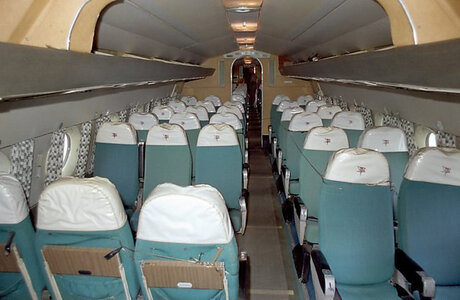
As November 1st 1966 arrived, so did the Comet at Gatwick. The aircraft flew to Tees-Side to enable more training to be carried out for a week. The second Comet was, at that time, undergoing the same refit at Lasham as her sister ship, which was scheduled to carry out a proving flight on Wednesday 16th November. The flights, along with 99 passengers, including Managing Director Alan Snudden, plus engineering and company members flew to Barcelona. Comet Fleet Stewardess and Judy Jacobs and airline Chief Stewardess Joy Moore worked under the command of Captain Walters.
Further such flights were carried out throughout the month in preparation for the Comet's revenue earning debut operating for Clarkson's Tours. The giant Tour Operator had part funded the Comet purchase and one of the duo would work exclusively for Clarkson's, the other was also largely chartered by the firm, but other Tour Operators did manage to charter flights as well.
Meanwhile, Britannia Airways' had been caught slightly off guard. They had retired their Constellations and had taken delivery of the first few Bristol Britannia prop-liners. In comparison, the Britannia was slow and lumbering. In order to improve their own image Britannia began offering all charter passengers on flights of two hours or more, a hot meal, therefore Britannia became the first charter carrier to offer their clients hot food. More often than not, a shepherd's Pie.
This unique selling point was at the expense of Dan-Air who were not offering the same until the Comet came along. Dan-Air had their own airline catering company and arrangements were hastily made to remedy the problem. The first two examples that entered the fleet were fully booked for the upcoming season. Passengers clamoured to get a holiday that offered jet travel.
More often than not, these new in flight meals would be standard fare that could be reheated. Sheppard's Pie, Sausage and Mash being two favourites. Tour operators would be willing to pay for hot food as a way of getting round the ATLB rules that stated inclusive holiday fares could not be lower than a standard scheduled air fare. Tour companies would therefore offer, flights (with meals), hotels, meals, drinks, transfers and excursions as part of a holiday. In an effort to boost the fare up to the regular scheduled air fare. One stewardess said:
"We started hot meals in about 1969 I think. Usually sausage and mash. The ovens on board worked quite well, but I was a terrible cook as I was still at home and had never cooked. The only way I could establish if a meal was cooked was to shove my finger in the mash to see it it was hot all the way trough. Meals came on these metallic trays that used to get quite hot. I burned my fingers and wrists regularly. We then placed them on an oblong plate. It wasn't Michelin star by any means. Still, flights to Palma could take about four hours on an Ambassador, so there was a lot more time available. On a Comet, the same flight from Gatwick was less than three hours. We even washed glasses until the plastic ones came about. With five stewardesses and more than a hundred passengers, and hungry pilots, doing a drinks service, a meal service, tea and coffee and then duty free in two and a half hours is not easy. We then had to clear the cabin of rubbish and store everything for landing. It was normal for us to be securing trolleys when we would hear 'Cabin crew seats for landing' - I admit I have landed in a Comet's loo. Because we had to have full uniform on for disembarkation, and I thought I had time to re-apply my lipstick!"
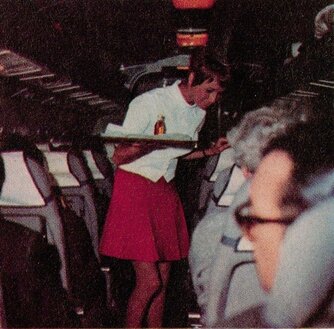
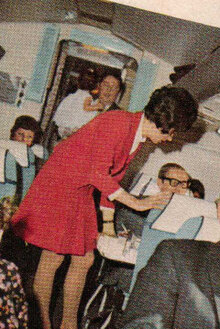
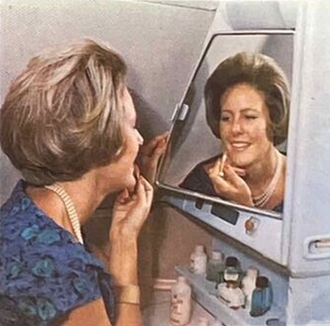
Above: Cabin Service on the Comet in 1972, including a look at the toilet!
The Comets had arrived at a very handy time. Monarch Airlines commenced operations in 1967 using Bristol Britannias, Caledonian and British Eagle were also using the type. BOAC were disposing of theirs and naturally charter carriers wanted them. Donaldson Aviation bought a couple of them, Dan-Air were in the enviable position of being able to offer jets to Tour Operators. For the 1967 summer season, two more joined the fleet, and by 1969 Dan-Air were operating eleven Comets on charter flights. Britannia's brand new Boeing 737 did not arrive until August 1968. Their order would see three delivered that year and further examples over the next few years. Resulting in thirteen 737s in 1975. The British Government had lobbied Britannia Airways to purchase the BAC 1-11, but their efforts ultimately failed. Foreign aircraft orders came with a tariff, but that didn't dissuade Britannia. The cost of a brand-new Boeing 737 in 1968 was £5 million. The Comet's relatively cheap price tag had enabled Dan-Air to have a substantial fleet before the 1960s had ended. In fact, in addition to the Comets, BAC 1-11 400 series twin-jets were sourced from American Airlines in 1969. These aircraft were less than three years old. The 1-11 had 89 seats and was ideal for European charter flights. The 189 seat Boeing 707 joined the fleet in 1971. Dan-Air's charter fleet stood at more than 20 aircraft as the 1970s started.
The Comet price tag was relatively cheap, at £1,074,000 for the first pair. The first; G-APDK was priced at £425,000, and the second G-APDO was £400,000. The reason for the difference was that the first aircraft had a longer time left before it was due to undergo major maintenance. The rest of the cost was for spare parts and ground equipment. It would be fair to say that Dan-Air was now very serious about their place in the IT market. The first Comet aircraft was paid for in cash, and the second would have a large part paid cash and the outstanding paid six monthly with 7% interest. The deal could also include initial pilot training and Dan-Air would pay for more crew to be trained on the type. BOAC provided technical manuals for Dan-Air to have a guide for their cabin services. BOAC had been operating their Comets in a way that would never suit Dan-Air. BOAC had used an 89 seat layout. The front section of the aircraft had been used as a first class cabin. A central cabin had five abreast seating and the economy cabin the same. The Comet 4 had a galley at the rear of the aircraft, manufactured by G.E.C and a large fridge by L.E.C the front of the aircraft had what was known as the pantry. By removing one of the inner bulkheads Dan-Air could seat more passengers. This would see engineers add extra windows, enabling all passengers to gain a better view of the landscape.
The BOAC seats were of the highest standards with a width of 17.5" this meant that no galley cart could pass along the aisle. BOAC had brought food and drink by hand. This was not a problem as they had been flying on long haul flights where time was not restricted. Dan-Air removed all the BOAC seats and used smaller, lighter seats with a 17" width. Seat pitch was reduced from 34" (first class) and 32" (Economy) to 29" throughout the single class cabin. Now Comets were able to accommodate 109 passengers. This was something never attempted before. To enable the aircraft to carry so many people, the floor had to be strengthened. The galleys were then reduced in size. These modifications were possible because the aircraft had a much greater range than Dan-Air would need. So the fuel would weigh less as the flights would be a maximum of 5 hours duration. This would mean that only one meal service would need to be carried. If the aircraft was chartered for a long haul flight then seats could be removed.
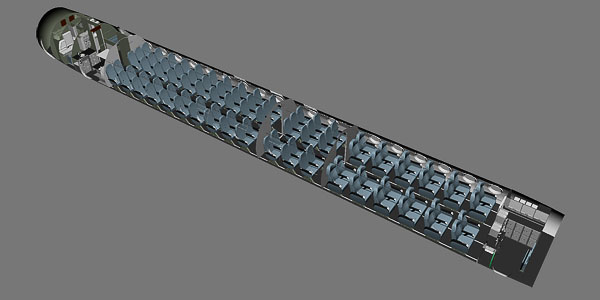

Above: 89 Seats on a BOAC Comet Right: Dan-Air Comet 4
Further engineering work had to be carried out to enable the aircraft to take of and land several times more than it was used to. The engineering division had carried out a superb job. The vast majority of passengers would have never experienced jet travel prior to this, so Dan-Air felt confident passengers would approve. The cabin crew were chosen from existing Dan-Air staff members.
Dan-Air could now fly more than a hundred people at 550 miles an hour to their holiday destinations. In a heartbeat they had jumped in front of their main rival, Britannia Airways. The seats that Dan-Air selected were, by today's examples, awful. The original BOAC curtains remained in place. Overhead coat and hat racks could not withstand weights that airliners of today can. Weight on board was also an issue. Passengers had just 15 kilo's baggage allowance. Carry on luggage was more generous, provided most of it went under the seat in front of you. Tickets indicated than in addition to the one piece of hand luggage, passengers could carry on board, a camera, binoculars, a ladies handbag, coat, walking stick, baby food and a reasonable amount of reading material! Food and drink was served on crockery with glassware and metal cutlery as standard. Very quickly passengers came to appreciate the high standards of Dan-Air cabin crew. Charter passengers would be offered a complimentary hot meal and tea or coffee. Before take off crew would pass through the cabin to offer passengers a boiled sweet to assist with 'ear popping' this was repeated as the aircraft came in to land. The bar service carried out by staff would offer soft and alcoholic drinks for sale. Duty free sales would also help boost revenue. In-flight entertainment consisted of a sheet of paper detailing the aircraft's route, along with information about height, speed, landing times, aircraft type and registration and the crew's names. This was passed around the cabin, allowing everyone to see.
Full details of Dan-Air's Comet modification specifications can be viewed here (pop up window)
SKY DINERS
Dan-Air was to revolutionise in-flight dining in 1969 when they became the first airline in the world to introduce a new concept in catering. Dan-Air's new 'Sky Diners' came about after management were seeking ways to reduce costs. Stainless steel cutlery, crockery and glassware when added together were heavy. On a single flight this might not add up to a great deal, but when you are operating a large fleet carrying a million passengers the numbers soon mount up. It was estimated in 1980 that by simply adding an orange to every passenger's meal over a year the fuel bill would be thousands of pounds. Studies carried out in 1969 suggested that the weight of catering supplies was costing almost £25,000 per year in fuel (£200,000 in 2023 prices) An evaluation of alternative products was carried out and one company came up with a solution - 'Sky Diners' and it soon became a branded product, exclusive to Dan-Air. The meals came with cold food in light-weight cardboard coated with foil and covered in company colours and logo. The box had a see through plastic lid. The plastic was emblazoned with the company logo and was designed to fit into standard airline ovens and trolleys. The box would be pre loaded with a cold starter, sandwiches or salad and dessert (Usually cake and biscuits). Accompaniments such as butter, salt, pepper and plastic cutlery were also included, wrapped by a napkin packed in cellophane. A plastic cup finished the box with creamer and sugar in small sachets inside the cup. The meals were novel if not entirely popular with passengers. Passengers might have enjoyed the novelty of them, but Dan-Air benefited financially. The whole tray was thrown away afterwards. Saving time and money by not having to wash the products.
Soon after, rival airline Britannia started their own version, with the capacity for storing hot food. Dan-Air were able to have lightweight resin meal boxes, that could be cooked in the oven on board the aircraft, and then placed inside a compartment of the second incarnation of the Sky Diner Box. This modification was minor as the trays already had foil linings. The new foil trays would be fully cooked at airport catering facilities before being boarded onto the aircraft. The galley would reheat the meal, which could then be handed out after passengers were given the tray complete with all the items listed above.
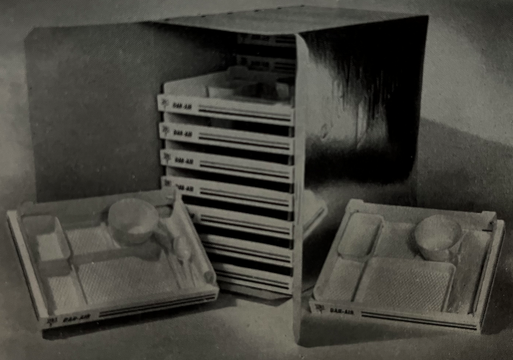
SKY DINERS
The Sky Diner meal concept is shown below on a publicity photograph taken at their launch. It didn't take Tour operators long before they embraced the concept and offered it to their clients. Scheduled and charter airlines across the World quickly rolled out similar products.
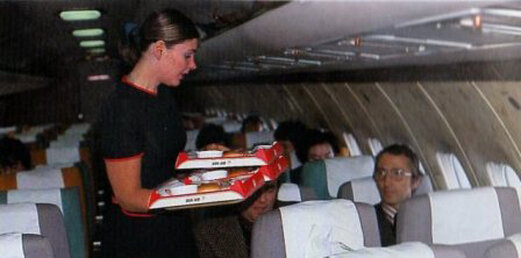
In the early 1970s Dan-Air had refined their catering even further, and when one looks at the catering manual from the period one can see that the aircraft carried a startling amount of extra food stuff. Comet aircraft carried between 300 and 400 glasses, and 200 paper cups! 1971 was to be a favourable year for bitter lemon drinkers with 18 cans carried. along with 24 Coca Colas, with many other canned drinks carried as well. There would be 48 Coffee packs and 50 Tea Bags 150 coffee whiteners were backed up with three pints of milk. The cabin crew were also responsible for ensuring that the correct number of Brillo Pad (3) fly killer, soap, deodorisers, disinfectant, and sick bags were stowed.
Crew would also ensure that bonded store goods, for duty free sales were on board and accounted for. The bar stock was also checked. Depending on the length of the flight and what the availability at the down route destination was. So, for example, up to 72 half bottles of whisky would be carried and usually 36 miniatures. Other spirits would be carried as well as cigarettes and perfumes, including six bottles of Chanel Number 5.
Each item would be stowed in a specific locker, making use of all available space. Whilst meals would be cooked in ovens, trays would be laid out in a meticulous pattern. Ambassador lunch menus would typically consist of two slices of cold beef, Grie & Potato salad and garnish. One roll and butter, a sweet, cheese portion, cologne towel and chocolate mint. Breakfasts would consist of Grapefruit segments, followed by a slice of Gammon Ham, a slice of cheese with tomato garnish, a hard boiled egg, one roll, one Melba toast, and two butters with one marmalade. Once again, a cologne towel and coffee or tea! Snacks were carried by way of a tin of assorted biscuits. It would appear that religious sensibility was not an option, nor was a vegetarian or vegan diet!
Different Tour Operators would select different menus and this would often lead to a certain amount of gripes from passengers. For example, Lunn Poly insisted on a cold selection on Comets, comprising Three slices of meat, one each of Liver Sausage, Virginia Ham and Pork. A Potato and sweetcorn salad with roll and butter. Followed by a pineapple ring, pear half and 3 pitted cherries. Finally 1 processed cheese portion and one packet of crackers. Those on shorter flights would be offered a pork pie, cheese and biscuits and a mini lemon sponge! Thomas Cook however ordered hot meals, breakfasts included; 2 rashers of grilled bacon, sausage, mushrooms and croque potatoes. BAC 1-11 passengers had a continental breakfast with Ryveta Biscuits! Lunch on a 1-11 would see silver side of beef and pork luncheon meat with a salad
Those on Comet lunch/dinner flights would have a steak and kidney pie with mixed vegetables and new potatoes with a fruit cocktail in jelly. All of these included cheese and biscuits and tea or coffee. Inbound passengers would be served Navarin of Lamb, with broad beans and new potatoes followed by apple pie. Transatlantic flights would enjoy prawn cocktails and two meals on a typical crossing.
Dan-Air's Comet Tray Layout
Dan-Air took part in several charters for Muslims flying on pilgrimage flights to Mecca using their Comets. These flights, known as 'Haj flights' were unique in that the passengers were not offered alcohol and had to be allowed to pray. Some flights even had the Imman use the PA system. Meals would be especially prepared to Islamic tradition with pork products left off the menu.
Above L-R : Haj flights - In flight entertainment seventies style!
A problem that faced the BAC 1-11 was the lack of oven. On shorter flights it was not so much of an issue, but is was becomming customary to offer hot meals on flights of more than a couple of hours. Salvation came when meals that had been fully cooked by caterers could be placed inside vacuum packed galley trolleys. The food could be stored in these and stay hot for up to three hours. Normally meals are served on board shortly after a bar service, thus giving crew plenty of time to sell drinks to passengers before feeding them. Caterers down route were given initial training and passengers returning to the UK could also be served hot food
Several tour operators had chosen Dan-Air from 1966-68 because of their jet capability, but rival airlines had started to take delivery of jets of their own. British Eagle, British United, Laker, Caledonian and Donaldson had all taken delivery of jet equipment. British European Airways had entered the charter market with a subsidiary airline BEA Airtours.
Court Line, the ship broking firm bought Autair International in 1965 and saw the company expand from Dakota aircraft to HS 748 and BAC 1-11. Autair had been a major client for Clarkson's Tours, who were by now the second largest UK Tour Operator and Dan-Air's biggest client. Autair had recently acquired two BAC 1-11s and as well as charter flights, operated scheduled services. Autair had been in financial difficulty when Clarkson's decided to use the airline to trial a new style of in-flight catering on charter flights. This cannot have done anything to help Autair's image. The new concept of in-flight catering was called 'seat back catering'. This, thankfully short lived concept promised that cabin crew would have a much easier time by not having to distribute 89 meals. The idea went down in aviation folklore as one of the biggest mistakes of all time. Clarkson's, although a huge company had a reputation for offering the cheapest holidays on the market, this innovation was in keeping with their cheap and cheerful mantra. Clarkson's also saw the added bonus that the removal of the galley would ensure - an extra row of seats!
This enabled Court Line to increase seating densities and reduce individual seat rates to allow tour operators to hold on to their market shares in a price-sensitive environment.
In 1970 Dan-Air, Clarkson's biggest client was forced into adopting the new method. That same year to coincide with Autair introducing the BAC 1-11 500 series Autair was re-branded as Court Line Aviation. The bright new look of the airline, their staff and corporate identity did a lot to mask the in-flight catering short comings. Many Clarkson's holidays that year would be operated by Court Line. Dan-Air was forced to match prices and product of the much smaller Court Line. This would include the dreaded 'Seat Back Catering'.
The main selling point of these meals was that passengers could eat their meal at the time of their choosing, as opposed to when the cabin crew gave it to them. The meal concept itself consisted of pre-packed meals or snacks - usually, Spam salads out and sandwiches back. these were loaded into a small, two-shelf compartment in the seat back of the passenger seat-back in front. The meal/snack for the outbound journey could be found in the top compartment, the one for the return trip in the lower section. The latter contained a pellet of dry ice placed under the plastic food container. This simple refrigeration technique prevented food for the return trip that would spend several hours inside a small, confined space from going off. For the airline's cabin staff, it eliminated handling trays while airborne and resulted in a reduction of their workload. To prevent outbound passengers from consuming meals intended for return passengers, locks needed to be installed on the lower compartment that could only be opened by cabin staff during the aircraft's turnaround at the destination airport. Although these were not effective at deterring determined passengers, who found that a pair of tweezers was all that was needed to open the box. In addition Great Universal Stores (GUS) subsidiary Global Holidays, having noted Clarkson's new idea, became the second major proponent of 'seat-back catering'. Global demanded that package holiday costs be driven down to the bare minimum by replacing the traditional meal service on holiday charter flights with something much cheaper that would simply give passengers 'a slice of pie'. Industry insiders referred to Global's new in flight catering concept as Global Pie. The cost advantage industry leaders such as Clarkson's and Global gained over their rivals as a result of their onboard catering innovation eventually forced every other major UK charter airline to adopt 'seat-back catering' on most flights serving short and medium haul IT destinations.
Above L-R - The in flight entertainment of the early seventies! - 1973 BAC 1-11 cabin - Seat back catering. - Comet in the 'new' style
One stewardess told us:
'Oh the bloody seat back catering saga - what a nightmare. The times I caught passengers getting into the return compartment....All they needed was a nail file or a coin and they were in. The concept was awful - we were told that it would mean we would have less work to do, because catering staff would load in the meals - If you can call them meals. We also got told how great it was that the passengers could eat their meals whenever they wanted - not at a time we decided to feed them. We announced to passengers that when they finished, to put the packaging back in the compartment. They did so, and often, if there was a bit of turbulence, the thing would come open and all the contents fell out. Passengers complained about them to me, saying that it wasn't like this when they went with Britannia last year, which was hilarious really. They didn't get fortnight's holiday for forty quid with Thomsons! The seats were also quite big and unattractive. I can't say that there was anything nice about them. Sometimes the ice would thaw, especially if we had been delayed. So a two hour delay in Tenerife would mean that the sandwich had been in that poky compartment for seven hours. They were revolting. I think they went out of fashion quickly afterwards when tour firms wanted to try and look a bit more upmarket. We were in a position to get our own back....As seats were pre allocated - they sat in the same seat going back as they did when they came - it didn't take the crew much hard work to find out the names of the guilty passengers who had devoured two meals. When these passengers returned home and looked for their meals they found a note from the crew saying as they had already eaten their meals on the outbound leg, there was no food available for them.'
The Court Line corporate look featured an all-over colour design by Peter Murdoch. In keeping with the holiday 'feel-good factor' of holidays. Each of their BAC 1-11s were painted in one of a distinctive, eye-catching pastel colour combination: yellow/gold/orange, pink/rose/magenta, pale violet/mauve/purple and finally light green/mid-green/forest green. The aircraft were given a name - Halcyon Skies. Aircrew wore trendy uniforms designed by Mary Quant. This was part of making passengers feel that the flight was a fun part of their holiday. For many, it would be their first flying experience.
Other airlines and tour operators were quick to jump on the burgeoning package holiday bandwagon. Clarkson's meteoric rise was entirely volume-based. It generated the required volumes by ruthlessly undercutting rivals and outbidding them to win the race for securing accommodation in popular overseas holiday resorts, especially in Spain.
Court Line and Clarksons Holidays were also a UK pioneer of the "time charter" concept, whereby the airline entered into a long-term relationship with the tour operator. This resulted in greater economic security for the charter airline industry and enabled it to acquire new aircraft on more favourable terms.
Despite all this cost cutting, in 1972 Clarkson's spectacularly went bust! The airline Court Line purchased them and within two years, they too had gone under. With Clarkson's no longer in business, there was no necessity to offer the seat back catering which had proven to be deeply unpopular with passengers. The other pioneer of the project, Global Holidays swiftly abandoned them too. By 1975 the concept was dead and buried. With the collapse of Court Line several aircraft became available to purchase as well as ground equipment and spares. Dan-Air purchased most of Court Lines's 1-11s and quickly absorbed them into their own fleet. Dan-Air also acquired Court Line's stores, including thousands of seat covers! Dan-Air's entire fleet was fitted with the Court Line seats. Michael Anciaux's picture above displays beautifully the 'new' look. This example was taken in Kinshasa where the aircraft was carrying out a charter. The seats were regularly lampooned by crew and still are widely ridiculed. One former stewardess says;
"Weren't they ghastly? I was used to seeing Court Line's jets, and I always thought they looked terrible. Even the interiors of their aircraft had those awful colours. To be honest, the seat covers we had up until then were not exactly attractive - they were a green colour with white head rests. Our uniforms were always smart, but Court Line dressed their girls in some terrible uniforms, designed by Mary Quant or not, they were not cabin crew uniforms as far as I was concerned. We lost a lot of business when Clarkson's went bust, but then it came back when other companies took Clarkson's work over. A few of Court Line's staff and crew came to us and they were great. I think they were shocked at the difference in our standards to Court Lines."
THE BOEING 707 & 727
In the early 1970s Dan-Air took delivery of its first dedicated long haul aircraft, the Boeing 707. The jets were configured with 189 passenger seats. They were, at the time of entering service, old aircraft. Being some of the first 707s that had been manufactured. Pan Am had purchased them new. Now, at the end of their career as luxury airliners, they were to start a new life as charter jets. British Midland had done the same thing. British Midland had opted to configure their 707s with 218 seats. These aircraft would operate on behalf of Tour Operators on the transatlantic group, affinity charters. You can find out more about these flights here. (1973) One stewardess on the 707 says:
'I started out on the Comet, and when the 707 joined the fleet I was desperate to convert. I was on the first course to familiarise the type. It was huge compared to the Comet. I am not a technical, so I didn't know if it was state of the art or not. It did seem to be modern compared to the Comet anyway. I had done several long haul charters, again on the Comet, I had done haj flights to Mecca, which is not really a party town! The aircraft came from Pan-Am and they still had lots of things that identified them as such. But Dan-Air were quick to put more seats in them! We had 189 passengers, which was pretty crap for the passengers on a long flight. It turns out that the aircraft were some of the first 707s to be built, thinking about it, why else would Pan-Am want rid of them! So, they would seem to crawl up the runway! Crews quickly nick-named two of them - G-AYSL was known as 'Sick Lil' or 'Spread Legs' because she was always going tech. G-AZTG was known as 'Tree Grazer' because the Captains said she wouldn't leave the ground! I would be filling tea-pots in the galley and you could actually feel the tail section swaying when it was a bit turbulent. We would eventually get to America and change crews, we would then wait for the next incoming flight to go home, often a week later. So often the aircraft would need repairs in America! We regularly landed in Greenland or Iceland and if the thing went tech en-route, it would be a nightmare. We would have to get passengers off and in the terminal or a hotel. The repairs would be carried out and because of the cold, new faults often emerged. There would be stuff freezing if the doors were open. Talk about glamour! Passengers didn't blame cabin crew - but they blamed the company!'
Above L-R: On board Boeing 707 - Service on a company BAC 1-11 In Flight Entertainment on the 707 - Viv Jansen on a company 1-11
Having 189 people on board a Boeing 707 en route to America taking more than 8 hours would mean that more than one bar service could be carried out. Drinks were made available to passengers for purchase. These included both alcoholic and soft drinks. Whilst food was served free as well as tea and coffee; everything else had to be paid for. Although bar sales were a valuable source of revenue Dan-Air did not over charge passengers. The drinks were slightly more expensive than land side bar prices. Today, Ryanair for example charge almost £4 (UK 2023) for a cup of coffee and upward of £6 (UK 2023) for a sandwich.
Above: Left: Dan Air considered purchasing the DC 8 - Centre: Boeing 707 cabin service - Right: The interior of a Vickers Viscount -
The Boeing 707 was used initially on Affinity Group Charters and later on the Advance Booking Charter (ABC) flights across the Atlantic. Several UK airlines scrambled to purchase or 707s from anywhere, in the hope that they could to grab a slice of the booming market. Lloyd International, Donaldson, Britannia, Monarch, Caledonian, Laker and British Airtours all operated them with varying degrees of success. Lloyd International and Donaldson collapsed in 1972 and 74 respectively. The ABC flights were low yield flights, in as much that the profit per passenger from the flight itself was minimal. The airline could only hope that ancillary sales would make the flights worthwhile. The old aircraft used would often break down, at the expense of the carrier. Within a very short time Britannia and Monarch were denied the right to fly the flights. Caledonian and Laker aimed at scheduled services across the Atlantic.
Travel Agents had unlawfully made bookings, by issuing membership to often bogus organisations that would permit them to fly on Affinity Groups Charters. Officials at UK airports were employed to check credentials, and deny boarding to those not deemed to be genuine members of clubs. Collectively, airlines were fined for allowing them to travel. The Advance Booking Charters that followed were an ideal solution. Whilst Dan-Air carried out the charters until the 707 was phased out in 1979, the company later said that the had not been profitable or successful.
In 1972 the airline ordered Boeing 727s from Japan Air Lines. Dan-Air had considered purchasing the Boeing 737 with a 140 seat configuration, ten more passengers than the 737's operated by Britannia. Once the 727 had been selected, the aircraft had to undergo major modifications to allow them to carry up to 151 people. Something the type had never done before. This necessitated installing extra over wing exits to permit an evacuation within 90 seconds. The 727 entered service in 1973 and was a hit with Tour Operators, in as much that it could carry a lot more people than the 737. The aircraft would fly to popular destinations. One ex-stewardess said:
"I loved and hated the 727. Firstly, it was bigger than the 737 and looked gorgeous from the outside. I always felt like it was a rock solid, safe as houses machine. On the down-side, the galley was in the centre of the cabin. From a passenger point of view, it would be on the right hand side, that did cause problems during cabin service, there would only be four of us serving meals and one girl in the galley. It was always a case of up and down the aisle. It just seemed a funny place to put a galley. When the larger 200 series joined the fleet there was a galley at the back and that seemed a lot more sensible. There is no doubt though, that the 727 was claustrophobic for a lot of people."
Another said;
'I was Manchester based and had worked on Comets and 1-11s. We found out that one of the new 727s would be based at MAN. The base stewardess asked if I was interested, and of course I was. I loved the aircraft from the moment I started on it. The only negative was the central galley. I think the 727 was a gorgeous aircraft to look at. It was fast as well. The front door was a challenge for me, I was very slight of build and I would pull at it and it would swing back onto the aircraft wall. Usually someone from the flight deck would help me, it was so solid. But we had some lovely flights. The Manchester passengers were so lovely. We would be able to take some of the kids - and their parents, into the flight deck. I think Dads enjoyed the experience more than the kids usually. We had a lot of night flights, but I was in my twenties and it was such fun. If you call flying back to MAN serving breakfast of Gammon and Pineapple at 4am fun! There were a few scary moments over the years. The odd tyre burst and the odd time smoke appeared in the galley - that incidentally was the fault of cleaning staff down route, who had left a cloth inside an oven!'
Dan-Air had based aircraft at Berlin Tegal airport from 1970 until the take-over. Several German tour operators chartered their aircraft for the blossoming West Berlin market. German cabin crew were recruited as well as English flight deck crew. The West German tour operators were more demanding of Dan-Air than their UK counterparts, insisting on an increased seat pitch. An engineer said:
'They wanted the Boeing 727 to carry a maximum of 141 passengers, which was only eighteen more than the standard layout for the type. Germans were used to paying more for their holidays so Dan-Air were happy to oblige. Other UK airlines began to muscle in with Laker and Britannia being the main competition. we were by far the most popular UK airline in Berlin - in fact. Neckemann was the Thomsons of Germany and they used us all the time. They had high standards. We had to install extra fuel tanks on the 727 to enable them to fly from Berlin to Tenerife, which was about five and a half hours flying time.'
One stewardess had an interesting take on the period.
'I worked on the Comet in the late 60s and I often reflect at passenger behaviour. I would be stood on the apron waiting for them to board and the first thing I noticed was how smart they all looked. Even those who had booked with a low price company like Clarkson's. Men nearly always had a jacket and tie on and it wasn't strange to see women wearing hats. They would have had their hair done and came on board like Audrey Hepburn. Many were nervous, but they were always, always polite and listened to your every instruction. They never got tanked up - and if you offered them the chance to go in the flight-deck it was as if they had won a prize. The aircraft was pretty much the same when they got off as it was when they got on. They tidied up after themselves. I see aircraft as I disembark today an they are like rubbish tips. We would arrive at our destination and the first thing to hit them was the heat. They were in their wool suits and must have been boiling. We were not allowed to accept tips, but that didn't stop people trying to give us money. Sometimes even putting it in our hands and wrapping our fingers round the money. These were not swanky rich people, they were ordinary working class people. Lord knows how long it took them to save up for their holiday, or how poor a life they lived at home. But it was special for them, and they made me feel like I was a bit special. It was hard work for us - up all hours and Dan-Air laying all the service standards down. I doubt the passengers expected half of what we provided, and that was also special for them - to get so much more than they thought they were getting. I would go and do it all again tomorrow - but not if it was to be like on today's airlines.'
Dan-Air would became the largest UK operator out of Tegal and the third largest of all airlines using the airport.
OIL FLIGHTS & DAKOTA REPLACEMENT
Dan-Air acquired Skyways International in the early 1970s and with it, a fleet of HS 748 prop-liners. They had evaluated several aircraft to replace the ageing DC3. These HS 748 aircraft were fitted with 44 seats. The short haul aircraft had a galley that could provide cold food and hot drinks. The 748 was introduced on Dan-Air's regional 'Link City' network.
A new series of charters began in the 1970s; Several 748s were chartered by oil companies operating oil rigs in the North Sea. By 1980 twelve 748s were based in Scotland providing these flights. Passengers would fly, usually from Aberdeen to Scatsa or Sumburgh in the Shetland Islands where they would then catch a helicopter flight directly to the oil rigs. Dan-Air was by far, the largest operator of these flights in the UK. The rugged design of the 748 enabled it to land on remote islands that other types were unable to serve. It is not unkind to say that the interiors of the aircraft reflected the work they did. When they first joined the fleet they were not very stylish on the inside! Several of the type were based in Aberdeen permanently. Others flew scheduled services. Due to the nature of their short flights in flight meals would generally be cold snacks. The 748 would often be the preferred aircraft for new routes, flying a 44 seat aircraft is easier than a large jet. Where services were popular, the 748 would make way for the introduction of the BAC 1-11 which served as both a scheduled service and charter liner.
The 748 fleet did receive makeovers when the company embarked on a new corporate identity in 1980. In 1992 one model was chartered by the Liberal Democrats for the General Election campaign. Vickers Viscounts also played a small part in Dan-Air's history and were usually leased with seating for between 60 and 80 they were used on Channel Islands and Northern European hops.
Above L-R: 1972 HS738 cabin interior - HS748 1980s interior - Vickers Viscount interior
IN FLIGHT ENTERTAINMENT
In-flight entertainment in the first thirty years of Dan-Air's existence was not something that most passengers would expect, or be aware of. Those travellers on flights across the Atlantic or Australia might enjoy a movie, shown on a drop down projection screen from the late 1960s. For the vast majority though, there was nothing by way of entertainment other than the flight itself, with spectacular views of the landscape passing by. Airlines started producing in-flight magazines that would serve many a purpose. The magazine would have the safety information for each type, as a pre runner to the laminated cards of today. There would be the bar tariff, adverts about duty free products and entertaining features about the airline or destinations. These would be presented as a souvenir to be taken home. Dan-Air also offered a novel way of keeping travellers informed. The in-flight bulletin. A printed map, with the relevant route being drawn by the flight deck crew. There would be details of outside temperature, altitude, speed, as well as the aircraft's registration, type and time of arrival. All crew members names were displayed - and then - the bulletin would be passed around the cabin - this might occupy the mind for a couple of minutes. Scheduled service passengers would be given complimentary newspapers and all passengers had at least a cup of tea to pass time. On Mediterranean charters, a meal might take up a good portion of the flight. Duty free sales also took a substantial part of the flight up, crew would be given training on how to sell the goods. Duty free goods earned the airline revenue, and commission for crew.
As many young passengers as possible would be invited to the flight deck to meet the pilots and marvel at the instruments. Just how much the flight deck crew enjoyed this, is not known. Several older passengers would also revel in the chance to visit 'up front' something that would now be inconceivable for security reasons. Dan-Air would provide younger passengers with a gift of a travel goodie bag. This bag would have pencils, a colouring book, Dan-Air eraser, toy and badge. Charter flights in the 70s were often flown through the night so travellers would be encouraged to sleep after cabin service. Alan Selby who was a Captain on the Comet, 727 and 737 said:
"Provided everything had gone smoothly with take off and the flight was progressing well, it was perfectly acceptable for children and sometimes adults, to come into the flight deck. It wasn't an inconvenience unless the flight was a bumpy one. Most children were very polite and only one or two asked endless questions. Most stood there in wonderment."
IN FLIGHT DINING - THE MANAGERS EXPLAIN
It is not easy to come up with meals for over a hundred people that everyone will like. Cabin services directors worked hard to ensure that the meals were attractive, the right price and tasty. These people behind the scenes had several theories, says one;
"We would never, for instance serve something too spicy, some might like it, but a lot would not. We tended to select meals that would have the broadest appeal. That is why chicken and beef were so common. Pork was not always ideal because of religious sensitivity."
Another manager told us;
"You have to remember, in the 1970s, that it was the done thing for Tour Operators to pre order meals months prior to departure. Without email and instant confirmation, a lot of secondary information could get lost. Then there is cost - we are carrying 150 people, who all get a meal. When you start saying - three vegetarian, four vegan, two Kosher, three salt free, six gluten free, five halal and so on you end up with about ten different meals on one flight. It is hardly cost effective. On a two and a half hour flight cabin crew would be preparing all these different meals that might need cooking for different times, it becomes a real headache, because then you have the paper work. You can't waste valuable time announcing on the PA system that you want all the vegans to identify themselves and next all those who want Halal food, so you have to have it written down that Mr Smith in 6a is diabetic and Mrs Jones in 22c is gluten free. We did not have that luxury, what's more is that tour operators just wouldn't pay for it."
Our catering manager went on;
"Travel agents were supposed to ask about things such as special dietary requirements. In my time we had very few appear. The cabin crew would say that passengers had complained because they had a specific need and the travel agent had not passed it on. We were limited anyway in the 70s and 80s, but that didn't help the cabin crew, who just smiled and nodded. Thankfully most passengers didn't mind what food they were offered as long as it fell into the category of good old English food! The breakfasts were always popular, we didn't have to offer salt free, vegetarian, kosher and halal options. That sort of thing did start to crop up more later on. For dinners we tended to stick with British style meals. We would never select Moussaka on a Greek flight say, or Lasagne on an Italian service. Passengers heading to a destination would be eating local meals whilst on holiday. We would not be able to compete with them, so it was avoided. We also tended to avoid messy and smelly food such as fish. Anything with bones in it, or food that had to be picked at would also not be served. Of course, food like fish would stink the cabin out. We also had to consider that it was not always practical to take food out for both outbound and inbound flights. Therefore we relied on the caterers in foreign countries to be able to prepare a suitable meal. With that in mind, we knew it was better to serve meals such chicken in a sauce with vegetables. It was decided when we obtained the Comet, that the galleys were just too big for what we needed. They were used to handling all the paraphernalia that goes with long haul flights. We just needed the space for meals that had been pre cooked to be reheated. All the hot meals would be cooked together and then placed on a tray that was already set out. That is why tray sizes shrank. The bottom line was - more galleys - less seats - higher prices. That said, we always had to make the tray look attractive. Over the years the meals did change. We even made the foils on top of the main meal have some kind of design on them. Bowls, dishes and cups were all especially selected. Dark colours were rejected because they make a meal less attractive. Light ones enhance the look. One also has to take into account the national palette. If the flight is a UK charter then we would generally opt for a British meal like Cottage Pie because the passengers would all be British. Scheduled flights were a little more difficult as the flight could have lots of, say, Spanish people on board. It was always best to choose pretty neutral meals."
Back to the second manager who has the final word;
"When the Sky Diners came on stream in, I think 69, 70 it was estimated that by ditching the steel cutlery and the reusable plates and so on, we would save a couple of pennies each meal. With a million passengers that amounted to about 40 grand. Which was big money back then....On the scheduled services we often provided fruit as a snack, and in the early 1980s I suggested that we might do that on Spanish charter flights as an additional snack. Some boffin went away and came back a short time later saying that adding an orange to the dessert we usually served would cost thousands over the year. I was also told that a return Boeing 727 would need space for 300 pieces of fruit which would take up the space of a person. My idea was quickly shelved. People don't realise that in the highly competitive world of the charter airline industry back in the 80s it really was the weight of a few bits of fruit that might be the difference between a profitable flight and loss making one."
It was often claimed that charter airlines crammed passengers into their cabins. This was certainly the case if one compares them to a large scheduled carrier on long haul flights. Those carriers could not afford to risk offending their passengers who had paid a hefty price for their ticket. Rules on how many passengers an aircraft could carry were laid down by the CAA. Adequate emergency exits would have to ensure that the aircraft could be evacuated within a limited time. Dan-Air suffered negative press for the very thing that all other operators were doing.
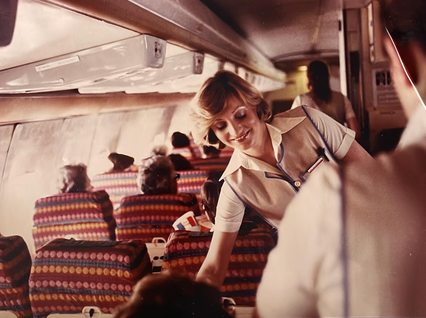
Cabin crew during the bar service on the Boeing 727 in 1978
Charter passengers may be paying less for their holidays than those who purchased a tailor made holiday from a travel agent using scheduled flights, but they were no less demanding in the level of service they required. Dan-Air's standard of passenger service was second to none amongst the airlines of the World. Their uniforms had to be stylish as they would be seen outside the aircraft. As well as the exacting standards on board, Dan-Air girls knew that their uniforms were scrutinised by management. Hair would only be allowed to be worn down if it was shorter than collar length. Otherwise it had to be tied up, and only with permitted ribbons in a specified colour. Jewellery was not permitted, other than pearl earrings, necklace and a small watch Tights would have to be the regulation colour - American Tan - and shoes the right height and colour. Hats should be worn as directed and gloves worn at all times when outside the aircraft. When one reads manuals about how drinks should be served and in what direction it is quite remarkable to see the standards the company set. Once the flight commenced cabin crew would wear a tabbard during bar and meal service, and remove their jacket and hat. One stewardess told us;
"I actually loved my uniform, after I had completed my training and went on my first flight I thought I had done really well. We arrived back at Gatwick on a 1-11, which has built in airstairs that lower from the tail section. I lowered them and went to the bottom of the steps to ensure everything was in order. I calmly finished dressing, putting my hat and jacket on while the passengers got ready to disembark. I then headed to the crew room to do my bar and duty free sales cashing up - No sooner had I sat down, when I was approached - by someone I won't name....She had been watching my flight with binoculars! I was told: 'At Dan-Air, our stewardesses are in FULL uniform when they are outside the aircraft - That includes hats!' She was stony faced, and I knew that it wasn't a gentle bit of advice, it was a telling off. I never forgot my hat again!! We were under scrutiny all the time, and I am glad we were. If we put a bit of weight on it was mentioned. I was once told: 'Our uniforms only go up to a size fourteen you know' In other words - lose weight. I was reprimanded for saying 'tea, tea, tea, tea as I walked down the aisle. I was instructed to smile and say 'Would you like a cup of tea sir?' We served passengers drinks starting with the passenger at the window, then the centre and finally the aisle. I would make sure that they had ice if they wished, a slice of lemon, a drinks mat, a stirrer and a napkin. We would never pour a hot drink and hand it to the passenger. I was trained to ask them to put their empty cup on the tray, I would then bring that to the aisle and pour in the tea or coffee. I would then present the tray to the passenger for them to take the cup. These standards became the norm to me. Imagine my horror when I was on a budget carrier recently and I was handed a small bottle of wine with a plastic glass upturned on the neck of it. I would have been fired! Even though our flights were charters, we always gave exceptional service. I honestly can say that I have flown on some of the world's leading airlines and the best of the best service is never any better than what we gave, ok the product itself might be a lot more upmarket - but no, the actual service - ours was world class."
A former Manchester Boeing 727 stewardesses told us.
'We had a terrible time in the late eighties with Airtours. They had suddenly got huge and we did tons of their flights - long before they got their own airline. Anyway, When we were doing a normal charter, the Tour Operator would have already decided what they were willing to feed their passengers. I'm not actually sure if they would say what meal exactly, just whether it was a hot meal, or a salad kind of thing. So, Airtours, and Intasun as well, to some extent, were not the most generous. One flight was particularly hellish. The flight was delayed because of a strike by Air Traffic Controllers, I think it was the French. So, by the time we got to go to the aircraft I was chatting to one of the handling agent staff and she had a terrible time, because Airtours had refused to give them any meals or drinks in the airport. Whereas Cosmos and Thomson had been great giving their customers vouchers. So our lot board the aircraft, and you could see that they were pretty much p*ssed off. Some you could see had enjoyed one or two beers as well! At that time though, they were p*ssed off at the French ATC and Intasun, not us. We get airborne and one man with his family said to me - 'I'm starving love, those so and so's at Airtours have given us nowt to eat.' - and he was actually rubbing his hands together in anticipation. I thought 'sh*t!!' - We come down the aisle with tea and coffee and a packet of biscuits for each person. It was mortifying - No matter how good a hostie you are, you can't make that look like a three course dinner. At first they thought it was a snack. It's three hours to Girona, so from our point of view it was fabulous, if it was Cosmos it was; do the drinks, do the food, do the teas, do the duty-free, clean up and land - which is tight in three hours. But, if you fling a pack of biccy's at them, the job is done in ten minutes! Well, word went round very quickly that that was all they were getting. One after another it went something like 'Hey love, I know it's not your fault - but this is bloody disgusting. I've been up since three this morning with the kids for a flight at 8, delayed for hours and given this piece of s*hite - is that the best you can do?' Words to that effect! Your hands are tied - you can't say: 'What you want me to do about it? Rustle you up a roast dinner in the galley? Book with a decent firm and you'll get fed! Of course you can't, so you say: 'I understand sir, but there's nothing I can do about it I'm afraid - and then we had to add the message- 'On charter flights the catering is as requested by your Tour Operator.' to the magazine, and on occasion as an announcement on the PA. They just didn't believe a word of it. Cosmos would have given them a free drink from the bar as well. But Airtours and Intasun were offering their holidays on the cheap. I guess you get what you pay for. The maddest thing of all was that if you flew with Intasun's own airline, Air Europe - the food was fabulous. I mean really excellent, and Airtours didn't do this to their clients when they started their airline either. I don't know if the Gatwick girls got the same - but our lot were from Lancashire and Yorkshire - and they don't hold back.'
The product that charter airlines could offer was limited. Especially when the actual flight was seldom more than four and a half hours long. Dan-Air had invested millions making thier cabins look brighter, more modern and clean. As the 1980s progressed some charter companies began offering in flight entertainment on their newer aircraft. Dan-Air had started to acquire new jets including the Boeing 737 300 and 400 series. Many airlines who flew the same type had installed video screens and audio channels. It is not known why Dan-Air decided against this. Depending on the airline, the headsets that enabled passengers to listen to films and music were either given free or sold on board. To not do what rivals were doing was not in the airline's interest. Some staff feared a certain mentality was ingrained on some of the older members of the board. One of our contributors felt that the board were not accustomed to 'splashing the cash'. Richard Branson said several years later that installing seat back video screens on his early Boeing 747s would cost £1 million per aircraft. The 737 was much smaller however, and small screens had been installed on cabin ceilings along the aisle. Some had drop down screens in the overhead panel, placed every few rows.
One former manager told us.
"The board were a lovely bunch of people to be honest. Some of them were from the most ordinary backgrounds and had worked in the company since the very beginning. I don't mean in management either. They came in on the factory floor so to speak and worked their way up. Of course they knew the airline inside out and the industry come to think of it. When I mentioned that I had travelled to America once on Air Europe one joked that I was a traitor. I told him about my experience about the films shown and the music channels - he said ' I would expect that on a transatlantic flight'. So showed him a copy of the in flight magazine that had all the entertainment listed including European flights. He was quite surprised that they were doing it. I told him about the little TV screens that came from the overhead panel and he listened intently. When I said we simply had to get on board and do the same thing - if only to make a profit out of the headset sales, he told me he would bring it up at the board meeting. I saw him later and he said he had mentioned it. I don't know if he did, but if he did, nothing was ever done about it. I think it was crazy I bet the headsets were pennies and they sold them for pounds. In the late eighties Britannia came up with this concept that all charter passengers would have better meals - I think it was called 'Royal Service' Basically it was a re-brand, but it was effective. Air 2000 were offering passengers complimentary Bucks Fizz at breakfast and hot towels. We had been offering 'cologne towels' since the 60s, but they were basically wet wipes in a plastic package, not a mini hot towel served with tongs. Whilst our service was excellent and no one could beat us on that, the product we were offering was weaker in comparison. Scheduled services were fantastic, we began or provide proper hot towels and gave real champagne to passengers. But the charters, to tell the absolute truth, we were falling behind with the product we supplied, not the service, the product."
This must have been frustrating for the cabin crew who loved working for the company. As new airlines sprang up, their own recruitment drives would start - often targeting Dan-Air staff. Several cabin crew were lured to the new airlines. Dan-Air lost a lot of staff to Air Europe in the late 1970s and history repeated itself again and again. By recruiting experienced cabin crew from Dan-Air, especially offering them a higher rank than the one they held at Dan-Air would often seal the deal. Airtours International directly approached Dan-Air crew and were successful in getting experienced crew to join them. When 'Class Elite' was launched in 1988 a whole raft of services were offered. Passengers would have dedicated check in area, the use of executive lounges at airports, priority boarding and disembarkation, hot towels, upgraded menus with real crockery and cutlery, complementary drinks, including champagne, wider seats, more legroom. Dan-Air guaranteed that on a row of three seats, the centre seat would never be sold. A table would be in place instead. There was even a chauffeur service to take you from airport to city centre. The service was praised by business travellers who said there was nothing to match it on short haul European flights. Our manager commented.
"Vic Sheppard was responsible for implementing 'Class Elite' he really put his heart and soul into the project. Our scheduled services were already well regarded. We had taken over British Airways on their loss making Heathrow - Inverness route. Mo Prerea was the base stewardess at Inverness. She had to follow company standards, but she went out of her way to bring extra touches to the route. Local preserves were served and she even ensured that grouse, fresh from the morning shoot was served on Burns' night. Cabin crew became used to seeing the same passengers on the route and remembered their names. There was such a lot of good will built on that service. When the business class started that same level of service was implemented. The thing was, as the new board came in they had decided that was where Dan-Air needed to be. So everything was thrown at the schedules. Our charter flights were operated with 727s, 1-11s and 737s. Other carriers were improving their charters, promising to bring them up to the standard of scheduled services. I think the new board just had little interest in charters. The staff still gave 100% on charters, but I think they were left adrift a little."
Above L-R 727 Cabin 1979 - Duty free sales 1982 - Meal service - Boeing 727 cabin
It is true that 'Class Elite' was, as the literature pointed out - Something Special In The Air.' Even the salt and pepper pots carried the company brand. Complimentary amenity kits for flights an hour long was much more than passengers had come to expect from even large legacy carriers. You can read all about Class Elite here.
As the eighties gave way to the nineties, a new uniform was introduced. Aircraft were re-fitted with new style seating and interiors. Plans were made to ditch all aircraft in the fleet with the exception of Boeing 737 and BAe146 aircraft. Charter flights would eventually be dropped leaving Dan-Air as a stand alone, two class scheduled airline. The history of Dan-Air told a very different story behind the scenes. Changes were vital, and with the benefit of hindsight David James might have been right with his aspirations as time has gone by and most charter airlines have ceased to be. The only two charter carriers are Britannia's successor - Tui and Jet2 who as well as operating charter flights as part of a package tour, also provide scheduled flights as low-cost carriers. The vast majority of passengers today are seat only, independent travellers. The internet has given people access to sites that in the eighties were only accessible to Travel Agents. Those very agents are fast disappearing too. Younger travellers are much more confident with online booking. By cutting out Travel Agents, a person is saving at least 6% of their holiday price. Ryanair famously stopped giving them any commission at all. Deregulation in 1992 gave EU state member airlines the freedom to set up bases wherever they wish in the EU, and thus fly from any carrier can fly between any two points within the EU. Even non-member states have joined the system allowing flights. The rise of low cost, no frills carriers would have been daunting for airlines like Dan-Air - The final word is from our ex manager.
"There is absolutely no doubt, had Dan-Air survived with James' strategy and gone on to become a successful scheduled carrier, things would have had to change in the late 90s. Whether Dan-Air would have tried to be a legacy carrier is up for debate. But even those airlines have started charging for things like luggage. When British Airways announced they were stopping their free drinks and meals on short haul flights I was shocked. So Dan-Air would be in the same boat. The thing that would have given Dan-Air the competitive advantage would be the slots that they held at a lot of airports. They would have had the routes in place. But to then go head to head with the likes of Ryanair would have been hard. Although not impossible. Dan-Air did usually offer scheduled service passengers the cheapest fares when in competition with other carriers.
Dan-Air did have fantastic training, which was costly to implement. Our staff received vouchers for dry cleaning of uniforms and there was a company pension with in work perks as well. Ryanair's cabin crew used to pay for their training at an external college. (changed recently, although the trainees still pay for accommodation during training) They pay for their uniform and have to provide their own food. Dan-Air was a generous company with staff travel and the totting system with the bar*. It would be hard to tell our crews that a lot of that would have to go. It seems to me that crew these days are treated far worse than ours were.'
*Totting - A system permitted by management. If, for example a flight had 10 Gin miniatures for sale and they were then sold out, should the crew believe they were going to sell many more, they were permitted to purchase a bottle from duty free. They could then serve a drink to a passenger at normal bar tariff prices. If, for example, the bottle cost £5, and a bar measure was £1, then, provided the crew sold five from the 'totting' bottle, the company hadn't lost out. If, from that 'Totting' bottle, the crew then went on to sell five or ten more drinks, then the £5 or £10 would be divided between the crew. If the bottle was not fully used, provided it was paid for - the crew could have the remaining contents for 'landing drinks'.


1992
Left: Boeing 727 Right: The BAe 146
The Boeing 707s, despite being widely used were not entirely ideal for Dan-Air's operation. They could be used for high density European charters, operationally they proved to be a pain. Apart from the technical issues they often faced, the crewing was challenging. The hours that crews can fly would not allow them to fly to America and return with the same crew after a short turnaround or rest period. In fact, because the number of flights was limited, returns would often see crews in hotels for a week at a time.
One stewardess said:
'Ok it was great if you were a single woman - which we all were, but I had a boyfriend and he didn't like me going to America every so often for a week. I missed him as well to be honest. The week away, would just be lounging round the pool and going to clubs at night-time. I would go shopping during the day, picking up things for friends and family, that were a lot cheaper than at home. We didn't have mobile phones, and so keeping in touch was impossible without a lot of expense. We didn't always work with the same crew either, so it was like being on holiday with strangers for a week. Most of the girls were great. Some of them had their hearts set on catching a husband from the the flight deck! There were romances too. Pilots were allowed to be married and they were away from their wives - it was inevitable really. I returned one day and my boyfriend was waiting with flowers and an engagement ring. I accepted his proposal. We set the date and I handed in my notice. Stewardesses could not be married then, so I returned to nursing. It was a really special time in my life that I will never forget. More so than the marriage, which sadly only lasted five years.'
Dan-Air's chairman said after just eight years of using the 707s, that they had been 'unsuccessful'. The affinity flights had also been a problem - many of the UK airlines had not stuck to the rules entirely. Transatlantic air travel was strictly controlled. The flights were a way of getting affinity groups to America on flights that were significantly cheaper than scheduled services. Soon after travel agents began started selling the seats, they began encouraging people to set up groups that would qualify them to travel. 'Bird Watching Groups' quickly sprung up all over the UK, and people were found not to be members of these groups at all. Despite the rules saying that people had to be members of such a group for three months, and have a specific reason to travel to the USA. Nevertheless Dan-Air obtained several Boeing 707 aircraft and alongside those flights they were put to use on round the World charters for a German Tour firm as well as flying several high density charters in Europe.
In 1978, Dan-Air had lost three senior board members. Errol Cossey, Alan Snudden and Martin O'Regan had been lobbying Fred Newman to purchase the Boeing 737 200 advanced. In a heartbeat this would leap frog Dan-Air over their rival, Britannia Airways who were operating the 200 series. Fred Newman refused, leading to the exodus. Three experienced airline men, left the company, Cossey and O'Regan went on to form Air Europe and Snudden went to Monarch Airlines. The group of three proceeded to take several Dan-Air pilots and cabin crew with them, including one of Dan-Air's training stewardesses, Renee Manchester who went to Air Europe. By 1979 the Comet was obsolete. The numbers in the fleet had dwindled to a handful.
The new airline, Air Europe, would train crews to the same high standards of service used at Dan-Air. The main difference would be the new aircraft type. Air Europe obtained the very aircraft that Fred Newman had refused to buy. The 737 200 Advanced. Air Europe launched a product that would go on to re-define how charter flights would operate in future. From now on, charter companies would offer more and more enticements to make their company the best to charter.
the year of Air Europe's launch saw Dan-Air with a fleet that still included thirteen very old Comets lining up alongside Air Europe's brand new Boeings. Any surplus capacity that was not taken up by AE's parent company Intasun, would be quickly snapped up by any Tour Operator who would be only too happy to have their clients on such a smart airliner. Captain Alan Selby says;
'Whilst I had no issues flying the Comet because it was a beautiful aircraft; the passengers did - That's the bottom line. Our rivals had much better fleets. I flew the 727 also, and that was, in my opinion, a superior aircraft to the 737 at the time. Passenger appeal was high on both types. The Comet, in comparison had a curtain for the flight deck door! It had curtains for passenger window blinds. By the time Air Europe rolled up next to you on the tarmac our aircraft just looked like old scrap heaps. You can offer the best service in the sky, but you just look bad. No matter how safe the Comet was, technology had made tremendous leaps by the late seventies. The doors were on the wrong side as every other aircraft, so we couldn't use air bridges. The Comet was smoky and often there were black oil stains all over the side of the aircraft. The doors were so tiny that people had to bend over to get inside it. When they did get aboard the thing, they would see that hat racks and the curtains. I really think it made us look old fashioned. That is probably where the Dan Dare thing came from. I was always proud to be a Dan-Air man, but I was, frankly embarrassed by the Comet.'
Another Captain told us;
'i remember the press junket that Air Europe had on their launch. O'Regan and Cossey were rightly boasting about the overhead lockers being the largest on the market and that the aircraft used so little fuel compared to anything else of a similar size. Everything about the airline was class. What's more, Fred Newman was aware of all of this. I have thought about this a lot over the years. Dan-Air had a really successful 1970s in terms of profit and how many passengers we carried. We had about 35-40% of all available charter passengers. We were in a position, I believe, to have obtained the 737s. We had managed to obtain fairly new 727s and there were ways of financing new aircraft. Fact of the matter is, Fred Newman didn't like spending money. I'm sure he would have been happy on a Comet. Tour Operators were not so happy to use them. I think it was Thomas Cooks in the end who more or less bullied him into getting them. Saying they wouldn't charter our aircraft anymore if he didn't.'
At the start of the eighties Dan-Air purchased the Boeing 727 200 series. This magnificent aircraft carried up to 189 passengers. The 200 series had a longer range than its predecessor, enabling it to reach destinations such as Luxor in Egypt. Aware of start up airlines eating into their market, Dan-Air did finally introduce the Boeing 737 to the fleet in 1980. the year the last of the Comets were retired. At last Dan-Air had caught up to their rivals and could compete head to head with Air Europe and Britannia. The rules governing long haul charters would also soon change. Enabling charter flights to Australia and the Far-East. Airlines including Britannia, Air Europe and Monarch went on to order the next generation of aircraft. Twin engined Boeing 757 with the capability to cross the Atlantic and the twin aisle Boeing 767 with seating for over 300 passengers. These passengers would receive in-flight audio and video entertainment. Something that would extend to European flights. Something Dan-Air chose not to compete with. Even shot-haul flights started offering head-sets to enable passengers to enjoy films and music.
It was not only Tour Operators who chartered Dan-Air aircraft. When the Ted Heath Government required the then Foreign Secretary, Alec Douglas Home to visit the Far East he and his party travelled on board a Dan-Air Comet. Paul McCartney and Mick Jagger have both chartered Dan-Air Comets. The company even carried the press corp that Accompanied Queen Elizabeth on one of her foreign tours flew on board a Boeing 727. In 1992 the Liberal Democrat leader Paddy Ashdown used a Hawker Siddeley 748 for his election tour. The Engineering division could quickly alter the cabin interior to cater for any demands the charterer had. As can be seen on the HS 748 picture, even the titles of the aircraft could be changed. In this case - 'Liberal Democrats' replaced the 'Dan-Air London' titles. The airline's famous compass and flag emblem was replaced with the Lib Dem's own logo. The staff at the paint shop could arrange that quickly too! Superb ground handling was carried out by Gatwick Handling, a company that Dan-Air had a 50% share in, along with Laker Airways.
Above The Liberal Democrats chartered a company 748 for the 1992. Alec Douglas Home boaring the Comet.
Without vertical integration from a Tour Operator Dan-Air were at a considerable disadvantage on the market. Naturally, Thomson would wish to use its own airline, Britannia Airways, where it could. The same thing applied with Intasun, who used their own airline, Air Europe and Cosmos with Monarch Airlines.
Dan-Air did have Tour Operators that would charter entire aircraft out for entire seasons. The large Tour Operators who did have an 'in house' airline often did not have a fleet large enough to carry out their entire programme. This would require them to charter aircraft from airlines like Dan-Air, who had the fleet size to be able to base aircraft permanently at several airports. The airline had the flexibility and skills to position aircraft at secondary airports for more random charters that might only see a couple of flights a week. A system of 'W' shaped flights would see an aircraft leave, for example, Manchester to Malta, then return to Leeds/Bradford. The aircraft would return to Malta and then back to Manchester. Very few airlines had the aircraft numbers to operate such flights. The vast majority of Tour Operators used Dan-Air. However the largest of them all, Thomson's, would seldom use Dan-Air. In the 1980s Thomsons did work with Dan-Air on their newly launched Paris Brochure.
By 1980 Air Europe had just four aircraft, and so, the vast bulk of Intasun's bookings continued to be flown using Dan-Air aircraft. The relationship between the two companies was a strange one. It was usual for a large company to time charter and entire aircraft. This would enable them to have a jet fly up to four return flights a day to popular destinations. Other options would be to charter an entire aircraft for specific flights, for example a flight to Corfu from Manchester once a week for the summer months. Air Europe did time charter as many as six Dan-Air aircraft at any given time. In other occasions, they would charter single aircraft for specific flights. When they did this, they would often require flights to be mid-week and for them to be night flights. This was the cheapest way to charter an aircraft. Another style of Intasun's style of operation would see them wait until the other Tour Operators had booked their entire seasonal programme. Only then, would they take up any remaining seats. This was possible where a Tour Operator may wish to charter 100 seats on weekly flights to A, B and C. Intasun would be aware that the Dan-Air aircraft had been already been chartered, and be aware that there would be upwards of 89 seats 'up for grabs'. Then, and only then, would Intasun charter this spare capacity. This would mean they could acquire seats at a much lower price than their competitors.
Rules had been in place from the 1950s until 1976 that would only allow a single Tour Operator to charter an entire aircraft. By 1976 trials allowing two Tour Operators to charter an aircraft between them had been successful. By 1978 the rules had been adapted to allow Tour Operators the freedom to charter small blocks of seats on any number of flights. It showed great skill that airlines like Dan-Air would used their own resources to make sure spare capacity to be filled.
Initially, Intasun's practice was a win-win for both them and Dan-Air, with the latter not flying aircraft with several empty seats and utilising aircraft that would otherwise be parked overnight at a UK airport. This only became a problem several years later, when fuel prices increased. Some of the older aircraft in Dan-Air's 'mix'n match' fleet were known to be fuel thirsty, and whilst having such a varied fleet meant that they were in position to offer Tour Operators aircraft ranging from 89 to 189 seats. Some of them had much higher fuel consumption than others. Britannia Airways operated 20 plus Boeing 737 200. The single type fleet could be monitored for fuel costs much more effectively.
Against this backdrop of steeply rising jet fuel prices, it became more and more difficult to offer Intasun the rates at which it was prepared to contract its business to Dan-Air. This meant that profits were eaten away with their higher costs. Late night and early morning flights that had catering provided now began to cost the Dan-Air more than a normal day time flight as caterers had to work outside normal hours. The caterers started to charge extra for that service.
Hot meals were provided on Boeing 727 and Boeing 737 Aircraft. The BAC 1-11 used vacuum packed hot meals which kept hot food hot for up to three hours. The HS 748 did not have an oven in the galley. Passengers would be provided with sandwiches and salads. In the 1980s, as standards improved, it had become usual to offer passengers hot breakfasts on morning flights. The vacuum packed meals would be used on 1-11 charter flights where a Tour Operator specifically asked for hot meals.
Market Research that was carried out by Tour Operators saw Dan-Air consistently scoring well for service. Passengers had, by now become much more used to flying and were all too aware that Dan-Air's aircraft were older than their rivals. Air Europe's charter flight catering standards rivalled the leading scheduled service airlines' European flights.
Despite lagging behind in key areas fleet renewal, every year Dan-Air were able to announce that they had 100% utilisation of their charter fleet. In the 1980s the airline was working with more than 130 different Tour Operators. It is inconceivable in today's market, that there would be so many charter airlines and so many Tour Operators. Dan-Air had the necessary experience to satisfy so many different companies. Something that none of their UK rivals could ever manage to do.
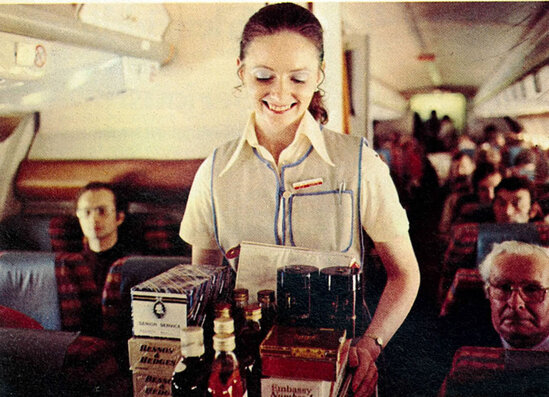
A Boeing 727 in 1979.
The Boeing 737s that Dan-Air purchased were, as one would expect, second hand! - They arrived in time for the 1980 season. The first machine was chartered for the season by Thomas Cook. The 737 entered service earlier than expected, as Guinness Peat, who Dan-Air leased aircraft from, had extra capacity for a wet lease operating scheduled services for Nigeria Airways in the winter months. Guinness Peat had a subsidiary company called Air Tara and they did not have sufficient capacity. Dan-Air seized upon this and the jet was sent to Nigeria. The second aircraft came from Transavia in the Netherlands. The two 737s would join the charter fleet alongside the seven Boeing 727 100, and the first of the three Boeing 727 200 series on order. To coincide with the new types being introduced, Dan-Air launched a new corporate identity. Each aircraft underwent a transformation as regular maintenance was carried out. A striking new livery was applied and the interiors were completely renovated. This would necessitate new carpets, seating, overhead luggage bins, lighting, toilets, customer service units, galleys and bulkheads. The cost was estimated at £1 million for a Boeing 727 and Dan-Air had now ten in their fleet. The new seats would be gold and blue coloured. To reflect the sand, sea and blue skies. The colours would be broken up throughout the cabin to promote, what described as 'a wide bodied look'.
Above: The corporate makeover revealed in 1980
The eighties saw a period of growth for Dan-Air which was outlined in an interview with Flight International. It was stated that the airline was considering new aircraft, including the Boeing 757. It did not foresee a time when it would enter the long range market again, in the future. The new aircraft would not be larger than a 200 seat type. In 1983 Dan-Air became the World's launch customer of the British Aerospace (BAe) 146. The BAe146 was marketed as the 'whisper jet' Over the years Dan-Air flew three variants of this popular high winged four jet aircraft. The 146 was used extensively on the scheduled network and became the only jet that could land at Berne.
Above: L-R The new look cabins for the 1980s - Far right tha Airbus.
The next few years saw rapid expansion of Dan-Air scheduled services. By 1989 a second cabin refit had been carried out. By now, brand new aircraft joined the fleet, direct from the manufacturer. The fuel savings and lower maintenance costs of new aircraft had paid off. The BAe 146 had significant savings over the BAC 1-11 and carried roughly the same amount of Passengers. The Boeing 737 fleet was enhanced by the arrival of never variants, the 300 and 400 series. Each new variant carrying more passengers that the previous example. To compete with Britannia and Air Europe's Boeing 767, Dan-Air introduced the Airbus A300 into the fleet. The A300 had 336 seats and would be ideal for charters to the most popular destinations. These high-density flights would usually be to Spain, the Canary Islands and Portugal. Captain Alan Selby recalls:
'It was an exciting time to be part of the UK airline scene. The newer aircraft were splendid models. The biggest problem we had, and it started in the mid 1980s, was the Boeing 727. I hate to even say that aloud. I was a fan of the 727. It performed exceptionally well. But, like we talked about before, it is the Comet story all over again. Aircraft, especially back then, have a shelf life. The 727 was not economical at all. The 200 model perhaps a little more so, in that it carried 189 passengers. Back in the 70s our Comet used as much fuel with 119 passengers as a DC10 with 345. We were in that sort of territory, for example, the 727 200 burned 4,500 kg of fuel an hour in cruise, the 767 burned the same, but they carried almost a hundred more people. The 737 400 used half the fuel per hour of a 727 100, yet the 737 400 had twenty more passengers. Those facts, to me, spoke for themselves. There is no room for nostalgia in the aviation business. We may have owned the 727 and were leasing the 737, but what a price to pay for owning them. The lease payments would increase the money going out - but maintenance, and fuel are the bottom line. The 727 should have been sold off and we should have got the newer models by 1988. I can't imagine that they were making any money for the airline at all. Unless everyone on board was paying for drinks and duty free. And that is not a way to rely on making money.'
The airline was carving an impressive record as a scheduled carrier, carrying over a million scheduled passengers by the late 1980s. Dan-Air gave its crew new uniforms and welcomed male cabin crew for the first time. A new class of cabin was unveiled in 1989. Class Elite was tagged as being 'What business class travel was meant to be." The first destination was Paris.
Dan-Air was awarded for serving the best tea in the world. Their own blend had been a winner with passengers, and the mystery judging panel.
Dan-Air said "How many airlines have forgotten the very things that made business class so special?" Going on to announce that when they sat down to design the new Class Elite that they went back to the basic principles with the intention of doing everything properly to provide a truly exclusive service. Beginning by arranging schedules that would most likely coincide with the business traveller. New check in desks were built. An executive lounge with a free bar, where you could check in also if you were only travelling with hand luggage. There was to be a superior class of cabin. They stated that 'If thirty six is the number its designed for on that aircraft then thirty six it is (and no more) Dan-Air remembered the little touches like a built in wardrobe on most flights, so that your coat won't get creased. Then there would be wider seats made to give passengers the ultimate in comfort and leg room. Next came the re-design of the cabin layout. The airline insisted that you would never be sandwiched between two passengers. The crew would welcome passengers with orange juice or champagne, or a combination of both before take off. You also received a copy of whichever National Daily Newspaper took your fancy! The flights would provide a free bar for the entire journey, a cooked breakfast plus lunch and dinner menus created by top European chefs. All of this served with stainless steel cutlery, with proper glasses for your wine, served by quietly efficient cabin staff who would cater for your every need. With hot and cold towels to freshen you before landing and priority disembarkation, you would, Dan-Air claimed, find that Class Elite was exactly as its name suggests. Class Elite would see a return to what flying Business Class on an established scheduled airline was 'always meant to be'.
They invited you to "JOIN THE CLASS ELITE" Dan-Air said that Class Elite would be available on ten of its European destinations. They invited you to "Insist that you're booked on Dan-Air Class Elite" Monte Carlo and Cannes passengers would even have a free helicopter transfer.
Above: Class Elite
Several tour operators dropped Dan-Air from their programmes from 1989 onwards. ILG announced 'We are cancelling our Dan-Air Engineering contract and reducing our chartering of their aircraft.' New airlines had began to spring up everywhere, many with the backing of a Tour Operator. Owners Abroad launched Air 2000, Air UK Leisure began with 40% backing from Unijet, and Aspro holidays launched Inter European. A further blow came when Airtours, one of Dan-Air's biggest contractors, started their own airline; Airtours International, who went on to grab several Dan-Air flight deck and cabin crew. The attractions being increased salary packages and the chance to work on brand new aircraft.
Intasun went even further, a year later, in 1990, when they said they were no longer going to use any Dan-Air at all - claiming that the reason was because of Dan Air's "Gas guzzling aircraft". Several highly trained cabin crew (including those who trained cabin crew for Dan-Air) were poached by these new airlines. The fledgling airlines all offered in flight entertainment. Including music channels and the latest cinema releases. Free use of headsets would be provided by some carriers, and others sold them, allowing passengers to keep them for use at home. These touches put the new airlines way out in front of Dan-Air, who chose not to compete, instead boasting that the 'Secret Is Service'.
Charter airlines offered tour operators all sorts of incentives to gain their business. From stainless steel cutlery for charter passengers (Caledonian) to pre take off bucks fizz and hot towels (Air 2000 & Airtours).
Above: L-R - On board one of the refitted 727s - Economy meal, BAC 1-11 - Final cabin interior, 727, BAe146 interior.
Should Dan-Air have survived they would have had to change their stance on IFE. Albeit only for a short time. In a few years charter carriers would have to face the onslaught of low fares, no frills, scheduled services. All the charter airlines around in the Seventies and Eighties have closed. With the exception of Britannia, who were taken over by German Tour Operator Tui. As well as providing charter flights Tui also compete with Scheduled Services - and there is not a single meal, in-flight entertainment, hot towel, Bucks Fizz or cup of coffee, unless you are paying for it!
In forums online, it has been speculated that should the company have seen out the tough economic cycle of the early 90s then it would have found itself in same market as Ryanair and Easy Jet. After all, Ryanair did not start off as a low fares airline, coming close to being wiped off the aviation map itself, before joining the low fare brigade. The decision to concentrate on scheduled services in the 1990s was, perhaps a good one. Had the fleet replacement that was planned, gone ahead. With valuable slots galore to many European destinations, Dan-Air might well have been in a position to succeed. Especially when armed with such a magic ingredient - Their cabin crew. Whilst the service on low fares carriers is constantly derided, that could never be said about Dan-Air.
It has never been the same not seeing the familiar Dan-Air aircraft and staff at airports. I for one would love to sit back, and not hesitate to use the call button located above my head to call for assistance. A gin and tonic? Will that be with Ice? To the girls and boys of the Dan-Air cabin crew - Cheers!
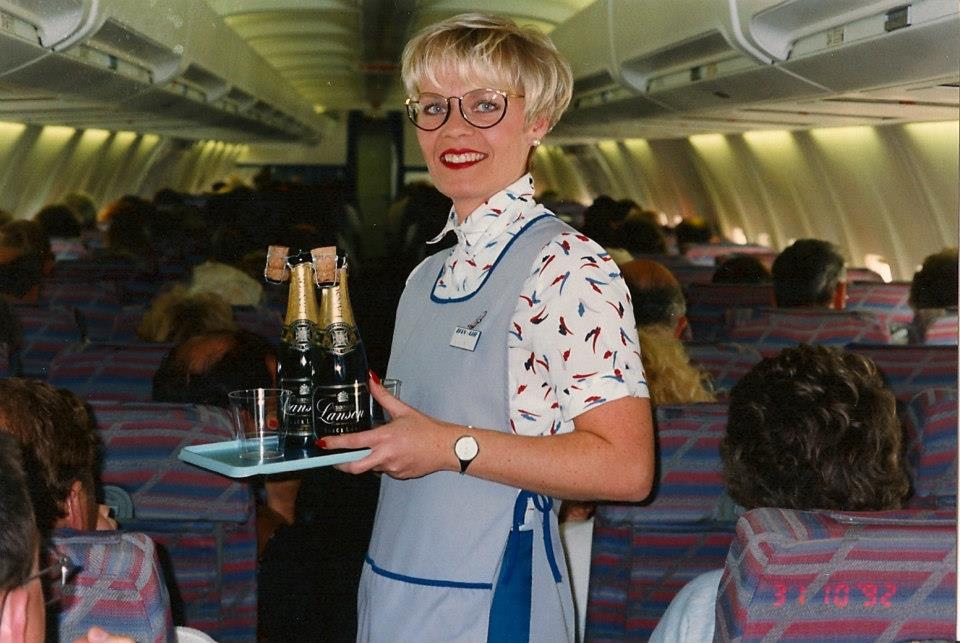
DISCUSS THIS SUBJECT
9
reviews
Rae
Thursday 16 Jan 2025
I flew with Dan-Air to San Antonio Ibiza in the late 80's. I remember having the door seats mid plane and they was bolt upright lol....Good old days :)
Lee SIMMONS
Wednesday 10 Jan 2024
ANY ONE REMEMBER ME LEE FROM THE DAN AIR TICKET DESK AT LHR, I LOVE MY DAN AIR, ALL THE TICKET STAFF KENW ME I WAS DESPERATELY UPSET WHEN DAN AIR WENT INTO BA HANDS`
Ahmed
Monday 16 Oct 2023
As a kid in the mid 80s I was familiar with Dan-Air at Monastir, Tunisia. Service was consistent and year-round from all over the UK and Berlin as well. I didn't catch the Comets, but the BAC1-11, the Boeings and the A300s yes. If someone here has a souvenir from any Tunisian destination, a seasonal timetable.. I'd be grateful if you could share it.
Danni Johnson
Sunday 11 Sep 2022
Lots of flights with Dan Air as a child in the 1980’s (81-87) ex MAN, before Tjaerborg holidays used Air 2000 from 1988 and Airtours had their own airline from 91, and flying Novair to Cyprus in 1990. I remember 727 to Palma a few times and once to Almeria. BAC 1-11-500 to Alicante and Malaga. 737-200 also i think on return from Almeria. The Dan Air flight operated by Airtours holidays didn’t include catering as such except a packet of three biscuits and a small cup inside a tiny packed tray, with branded Dan Air creamer, sugar and a hot towel. There was always a bar service before and sometimes pre landing; I was allowed a 7-up that came with a small packet of peanuts. I agree with the comments on here that Dan Air fell really behind the other charters: Britannia already showed movies on their 767s since 84 and the 757s and 737-400s of Monarch, AE, Novair and Air 2000 started to offer headsets to watch the inflight entertainment showed on a few TV monitors mounted on the cabin ceiling. Air 2000 were remarkable and the ones offering the bucks fizz, menus and real cutlery unfortunately once we flew with them in 1988 we ever went back to Dan Air. They had a bad reputation unfortunately, mostly due to old smaller aircraft and disappointing meals and service. Its a pity they didn’t order the 757s too, they would have saved loads in fuel costs compared to thise 727s and 1-11s. Not sure the strategy, but the decision of getting rid was too late in my opinion.
David
Tuesday 07 Jun 2022
I flew from UK to Athens in April, 1980 in a comet aircraft. Whilst there heard about the crash of 727 and was thankful to have been in the comet. The return turned out to be in a 727. I also flew in on of the 1-11 with seat back catering. The fruit juice spilled out as the aircraft took off, causing Dan Air to pay for dry cleaning of trousers.
Jubert
Monday 14 Feb 2022
I worked for Dan Air London Victoria terminal.
Lovely moments, staff as well.
Gold memories
Flew lydd to Beauvais
I miss so much this company
Lovely moments, staff as well.
Gold memories
Flew lydd to Beauvais
I miss so much this company
Johannes Bols
Monday 22 Mar 2021
This page is packed with info about DanAir. I've always known about the airline, but the detail here is manna from heaven. The bit about clever passengers using tweezers to nick the inbound seatback meals is priceless!
Incidentally, my two most underwhelming experiences on British Airways were in steerage, and the other one, surprisingly enough First Class LHR - SEA in 2008. I mean, I'm sorry that I upgraded from Club World to FIRST! You had to actually bring me my food AND wine! Everybody but this sullen hostess was brilliant. But WHAT a downer she was!
Incidentally, my two most underwhelming experiences on British Airways were in steerage, and the other one, surprisingly enough First Class LHR - SEA in 2008. I mean, I'm sorry that I upgraded from Club World to FIRST! You had to actually bring me my food AND wine! Everybody but this sullen hostess was brilliant. But WHAT a downer she was!
Rachel Simonds
Sunday 19 Jul 2020
So touched to see the positive description of the airline and crews. I few as cabin crew 1975 to 1978 on Comet , BAC 1.11 and 727. Many great memories of these years particularly of the RAF Comet crews who came with the aircraft.
David Libby
Thursday 30 Apr 2020
Excellent British International carrier providing brilliant service!
Flew LGW/AGP/LGW with my family on a "Package Holiday" Flight/Meals Accommodation, September 1980
plus I used to fly from LHR to INV BAC 1-11/Boeing 737-300 service 80s/90s, excellent service!!
Thanks for great flights and service.
David Libby.
Flew LGW/AGP/LGW with my family on a "Package Holiday" Flight/Meals Accommodation, September 1980
plus I used to fly from LHR to INV BAC 1-11/Boeing 737-300 service 80s/90s, excellent service!!
Thanks for great flights and service.
David Libby.
